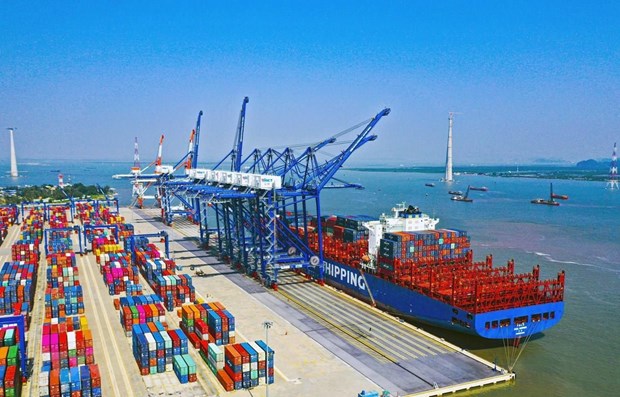 Economy
Economy

 |
| Goods are loaded for exports at Lạch Huyện International Port in the northern city of Hải Phòng. Increasing competitiveness and integration with global value chains support rising Việt Nam’s economic strength. VNA/VNS Photo |
HÀ NỘI — Moody's Investors Service has upgraded the Government of Việt Nam's long-term issuer and senior unsecured ratings to Ba2 from Ba3 and changed the outlook to stable from positive.
Under a report released on Tuesday, Moody’s said: “The upgrade to Ba2 reflects Việt Nam's growing economic strengths relative to peers and greater resilience to external macroeconomic shocks that are indicative of improved policy effectiveness, and which Moody's expects to continue as the economy benefits from supply chain reconfiguration, export diversification and continued inbound investment in manufacturing.
“The rating also reflects a sounder fiscal footing backed by contained borrowing costs, a conservative approach to fiscal policy and improved government liquidity, driven by the ongoing transition from external concessional borrowing toward longer-dated, low-cost domestic market financing.”
The stable outlook reflects a balance of risks to the rating. On the positive front, Moody's expects continued improvements in economic competitiveness to support rising incomes and advancements in fiscal prudence demonstrated through the execution of a more systematic, long-term debt management strategy and an increasing emphasis in fiscal policy on long-term challenges, including improving worker productivity and mitigating against physical climate risks. On the downside, the relatively low capitalisation levels of State-owned banks coupled with high domestic credit growth and potential risks from the real estate sector pose risks to the real economy in the event of a shock. Uncertainties relating to regional and global geopolitical tensions, higher imported input prices and uncertain growth prospects in Việt Nam's key trading partners may also pose limits to external surpluses for Việt Nam's trade-reliant economy.
Concurrent to the upgrade, Việt Nam's local- and foreign-currency ceilings are raised by one notch to Baa2 from Baa3 and Ba1 from Ba2, respectively. The Baa2 local currency ceiling, three notches above the sovereign rating, reflects relatively opaque government decision-making and the significant, though shrinking, government footprint in the economy, balanced by moderate political risks and low external imbalances. The foreign currency ceiling at Ba1, two notches below the local-currency ceiling, reflects existing constraints to capital flows that point to possible transfer and convertibility restrictions being imposed at times of perceived need.
According to Moody’s, increasing competitiveness and integration with global value chains support rising Việt Nam’s economic strength.
The increasing demand for Vietnamese exports through the coronavirus pandemic underpins the growing competitiveness of Việt Nam's manufacturing sector, which has outperformed regional peers in the attraction of foreign direct investment (FDI) and has driven a rapid rise in per capita income. Trade tensions between the US and China, as well as the supply chain disruptions due to the waves of lockdowns within China, have accelerated manufacturing investment in Việt Nam given the similarity of Việt Nam's exports compared with China's among Asia-Pacific economies, along with an ample supply of relatively low-cost labour.
Moody's expects Việt Nam's centrality to multiple regional and bilateral trade agreements to affirm its entrenched position in global value chains. Việt Nam is a party to the Regional Comprehensive Economic Partnership (RCEP) and the Comprehensive and Progressive Agreement for Trans-Pacific Partnership (CPTPP) and bilateral Free Trade Agreements (FTAs) with South Korea, and more recently, with the European Union and the United Kingdom. These trade agreements will strengthen Việt Nam's competitive position in lower-value products such as footwear, garments and agricultural goods, while placing it firmly in higher-value-added regional tech supply chains for smartphones, computers and other electronic products.
Under the report, Moody’s said Việt Nam’s fiscal capacity will improve, supported by prudent debt management policies and increased focus on long-term risks.
“Fiscal policy effectiveness has improved, including a greater emphasis on medium-term budget planning and the deepening of domestic, low-cost financing sources. The National Assembly has also lowered the statutory public debt ceiling to 60 per cent of GDP from 65 per cent to better anchor debt levels while preserving fiscal flexibility amid the ongoing economic recovery,” Moody’s said, noting however, transparency regarding contingent liabilities remains limited, including the size and financial performance of large state-owned enterprises, and delays in the execution of the government's large public investment budget are credit constraints.
Moody's expects Việt Nam’s fiscal deficit to be marginally higher at around 3.8 per cent in 2022, in line with the Ba-rated median, as the authorities implement the VNĐ350 trillion socio-economic recovery and development programme.
The country's fiscal deficit is forecast to consolidate to around 2.7 per cent by 2025, with the government debt burden set to decline to around 37 per cent. — VNS